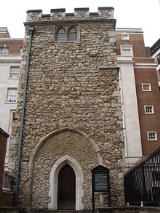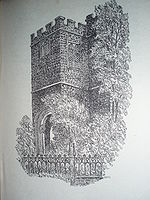
All Hallows Staining
Encyclopedia
All Hallows Staining was a Church of England
church located at the junction of Fenchurch Avenue and Billiter Street in the north-eastern corner of Langbourn
ward in the City of London
, close to Fenchurch Street railway station
. All that remains of the church is the tower, built around 1320 AD as part of the second church on the site. Use of the grounds around the church is the subject of the Allhallows Staining Church Act 2010.
The old church survived the Great Fire of London
in 1666 but collapsed five years later in 1671. It was thought its foundations had been weakened by too many burials in the churchyard close to the church walls. The church was rebuilt in 1674.
 The parishes of All Hallows Staining and nearby St Olave Hart Street
The parishes of All Hallows Staining and nearby St Olave Hart Street
were combined in 1870. At that time All Hallows Staining was demolished, leaving only the tower.
St Olave Hart Street was badly damaged by bombs in 1941, during the Second World War. Between 1948 and 1954, when the restored St Olave's was reopened, a prefabricated church stood on the site of All Hallows Staining. This was known as St Olave Mark Lane. The tower of All Hallows Staining was used as the chancel of the temporary church.
The tower of All Hallows Staining is maintained by the Worshipful Company of Clothworkers
, one of the livery companies
of the City of London. In 1957 the Clothworkers' Company built a church hall for St Olave Hart Street on the site of All Hallows Staining. The old tower now stands at the back of a small courtyard next to the new hall; and the remains of the church were designated a Grade I listed building on 4 January 1950.
The remains of 'Lambe's Chapel Crypt', lies under the adjacent yard. It was moved from the site of Lambe's Chapel in Monkswell Street and rebuilt here in the mid–12th century. It was said to have formed part of the 'Hermitage of St James on the Wall'.
These remains were designated Grade II at the same time as the main tower. William Lambe became a master of the Clothworkers.
Church of England
The Church of England is the officially established Christian church in England and the Mother Church of the worldwide Anglican Communion. The church considers itself within the tradition of Western Christianity and dates its formal establishment principally to the mission to England by St...
church located at the junction of Fenchurch Avenue and Billiter Street in the north-eastern corner of Langbourn
Langbourn
Langbourn is one of the 25 ancient wards in the City of London. It reputably is named after a supposed buried stream in the vicinity.It is a small ward; a long thin area, in shape similar to a left pointing arrow...
ward in the City of London
City of London
The City of London is a small area within Greater London, England. It is the historic core of London around which the modern conurbation grew and has held city status since time immemorial. The City’s boundaries have remained almost unchanged since the Middle Ages, and it is now only a tiny part of...
, close to Fenchurch Street railway station
Fenchurch Street railway station
Fenchurch Street railway station, also known as London Fenchurch Street, is a central London railway terminus in the south eastern corner of the City of London, England. The station is one of the smallest terminals in London in terms of platforms and one of the most intensively operated...
. All that remains of the church is the tower, built around 1320 AD as part of the second church on the site. Use of the grounds around the church is the subject of the Allhallows Staining Church Act 2010.
History
The first mention of the church was in the late 12th century. It was named "Staining", which means stone, to distinguish it from the other churches of All Hallows in the City of London, which were wooden.The old church survived the Great Fire of London
Great Fire of London
The Great Fire of London was a major conflagration that swept through the central parts of the English city of London, from Sunday, 2 September to Wednesday, 5 September 1666. The fire gutted the medieval City of London inside the old Roman City Wall...
in 1666 but collapsed five years later in 1671. It was thought its foundations had been weakened by too many burials in the churchyard close to the church walls. The church was rebuilt in 1674.

St Olave Hart Street
St Olave Hart Street is a Church of England church in the City of London, located on the corner of Hart Street and Seething Lane near Fenchurch Street railway station....
were combined in 1870. At that time All Hallows Staining was demolished, leaving only the tower.
St Olave Hart Street was badly damaged by bombs in 1941, during the Second World War. Between 1948 and 1954, when the restored St Olave's was reopened, a prefabricated church stood on the site of All Hallows Staining. This was known as St Olave Mark Lane. The tower of All Hallows Staining was used as the chancel of the temporary church.
The tower of All Hallows Staining is maintained by the Worshipful Company of Clothworkers
Worshipful Company of Clothworkers
The Worshipful Company of Clothworkers was incorporated by Royal Charter in 1528, formed by the amalgamation of its two predecessor Companies, the Fullers and the Shearmen...
, one of the livery companies
Livery Company
The Livery Companies are 108 trade associations in the City of London, almost all of which are known as the "Worshipful Company of" the relevant trade, craft or profession. The medieval Companies originally developed as guilds and were responsible for the regulation of their trades, controlling,...
of the City of London. In 1957 the Clothworkers' Company built a church hall for St Olave Hart Street on the site of All Hallows Staining. The old tower now stands at the back of a small courtyard next to the new hall; and the remains of the church were designated a Grade I listed building on 4 January 1950.
The remains of 'Lambe's Chapel Crypt', lies under the adjacent yard. It was moved from the site of Lambe's Chapel in Monkswell Street and rebuilt here in the mid–12th century. It was said to have formed part of the 'Hermitage of St James on the Wall'.
These remains were designated Grade II at the same time as the main tower. William Lambe became a master of the Clothworkers.

